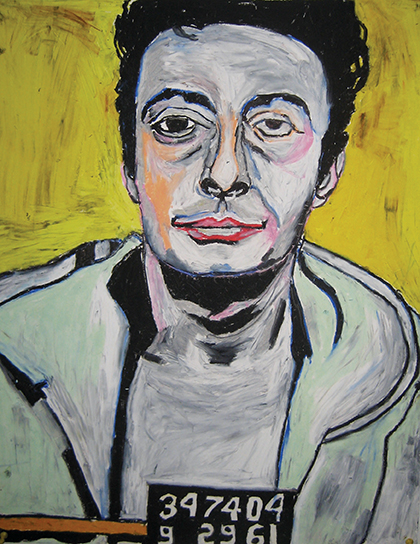How to Talk Dirty and Influence People: Lenny Bruce and Brandeis
There is a certain line of conversation that mourns the death of modern art: Jackson Pollock paintings hang in museums; nudity on screen earns a yawn; smoking bans and clean-living musicians have reduced jazz to an obscure genre heard only at Lincoln Center. You would think that art has lost its power to shock.
Turns out it hasn’t. On September 26, the Brandeis University Department of Theater Arts announced that a scheduled production of Buyer Beware, a new play by noted playwright Michael Weller, would not be performed in conjunction with his receipt of the Creative Arts Award at the Waltham campus in January. Weller drafted a play based on the work of comedian Lenny Bruce (1925–1966) during a residency at Brandeis, which has recently opened the Lenny Bruce archives, a trove of writings and recordings by the controversial comedian. As production unfolded, students, faculty and alumni raised concerns that language in the play—in particular the use of a notorious racial epithet—would violate Brandeis’s mission of creating an inclusive campus. After a he-said, she-said barrage of comments and press releases, Brandeis and the artist parted ways, sort of: Weller will still be honored in January, and Buyer Beware will still be produced—at an off-campus venue—this spring while the college convenes a class devoted to “analyzing and openly discussing provocative works of art.”
So, what might go on the syllabus for this spring’s course? The first task, for students who’ve only ever seen Marcel Duchamp’s Fountain in a museum or heard jazz in a concert hall, is to restore the sense of shock and social marginality that was so central to modernism. Writer Kevin Birmingham’s The Most Dangerous Book: The Battle for James Joyce’s Ulysses (2014) reminds us that Lenny Bruce had generations of provocative predecessors. By the 1960s, restrictive laws remained on the books, as Bruce himself learned when New York State convicted him of obscenity in New York in 1964. When the so-called “sick comics”—Lenny Bruce, Mort Sahl, Dick Gregory—burst on stage in the late 1950s, they challenged not only social norms but legal ones, aptly traced in Rochelle Gurstein’s The Repeal of Reticence: A History of America’s Cultural and Legal Struggles Over Free Speech, Obscenity, Sexual Liberation, and Modern Art (1996).
Jeremy Dauber’s new book Jewish Comedy: A Serious History (2017) will place Lenny Bruce in a longer tradition of satire and subterfuge. A dizzying array of anti-Semitic epithets and Yiddish obscenities filled Bruce’s repertoire of offense, and unpacking those at Brandeis—which describes its 1948 founding as “rooted in Jewish values”—is crucial to how language has affected Brandeis students past and present. Yet not all epithets are the same, and not all students feel equally at home on campus. In November 2015, the Brandeis campus was rocked by protests and a sit-in by students of color and allies who demanded a more inclusive climate.
Michael Weller’s residency did not coincide with those protests, but the proposed course has much to learn from them, as it would from Emerson College writing professor Jabari Asim’s The N Word: Who Can Say It, Who Shouldn’t, and Why (2007), a remarkable history of how the word both has been used as a weapon of hatred and taken up by black artists, writers and activists. There is a certain irony to the fact that in the 1960s, even as obscenity laws prosecuted Bruce for using the word schmuck, this country’s most hateful racial epithet circulated just offstage. Bruce’s audiences wouldn’t have used it in polite conversation. But they would have heard it, whether in the shouts that greeted the first African American students to integrate southern universities or the slurred, dog-whistle pronunciation of “Negro” proffered by segregationist politicians such as George Wallace. When Lenny Bruce worked it into his routines, he packaged it together with everything else he found obscene about a Cold War America that shut out anything “impolite.”
In case you were living under a rock during the last election, that world is gone now. Feminist and critical race scholars have asked where the provocative art and performance that emerged from certain kinds of white men in the 1960s has brought us. Lenny Bruce, author of How to Talk Dirty and Influence People (1965), would have made good material of all this. But that doesn’t mean he gets the last word.
Christopher Capozzola is associate professor
of history at the Massachusetts Institute of Technology.
Image: Jamie Roux, Lenny Bruce, 14 x 17″, 2011, oil pastel on paper. Courtesy of the artist.

